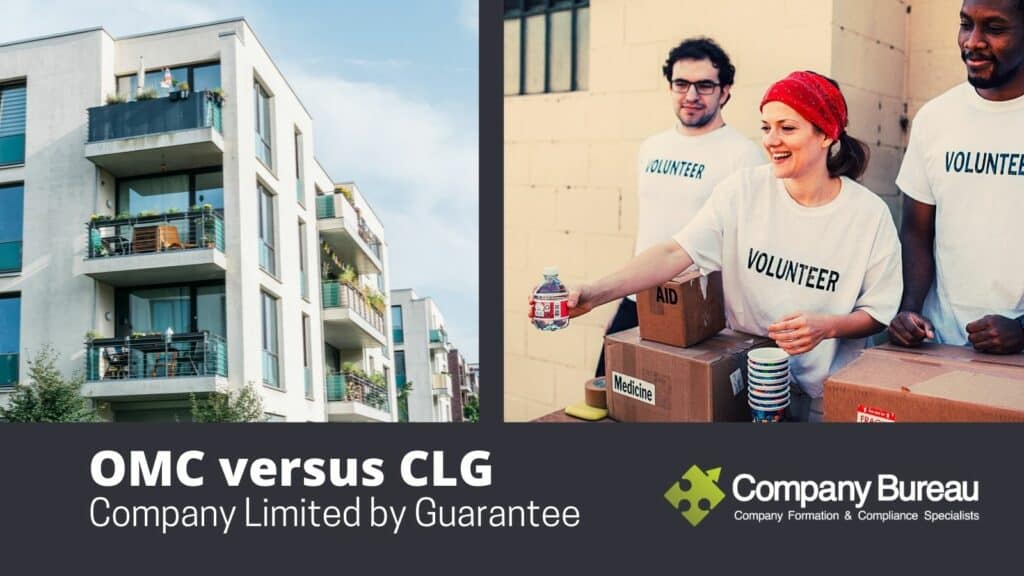Blog
Company Limited by Guarantee versus Owners’ Management Company
By Ashley Coakley, 1st December 2021
A standard Company Limited by Guarantee and an Owners’ Management Company are similar in that they are both limited by guarantee and incorporated using a CLG Company Type. Both are not for profit and have members instead of shareholders. However, each is used for a specific purpose and must follow a distinct set of rules.
What is a Company Limited by Guarantee?
A Company Limited by Guarantee (CLG) is a non-profitable body that is set up for a specific purpose such as to relieve poverty or to benefit the community. This may be achieved through the provision of a charity, trade association, society, sports club, or social club.
A CLG type company has members as opposed to shareholders and does not have a share capital. Members act like shareholders as they have an interest in the operation of the association, however, they do not earn a profit as shareholders do. The members also have limited liability, in the event of insolvency, the guarantors will only be liable for the amount stated within the company’s Memorandum and Articles of Association which can be as little as 1 euro. Each member is entered into the register of members once the company is incorporated and is obliged to carry out specific duties as per the Companies Act 2014 and the company’s Constitution.
Requirements of a CLG
The following requirements of a Company Limited by Guarantee are set out by Section 18 of the Companies Act 2014:
- There must be at least two Company Directors.
- There must be at least one Company Secretary.
- There must be at least one Member, except where the company is a charity where three unrelated directors and three unrelated members are required.
- The company suffix must read ‘Company Limited By Guarantee’ or ‘Cuideachta faoi Theorainn Ráthaíochta’ however, there are some exceptions to this rule where the company is either a charity or the objects are the promotion of commerce, art, science, education, religion or charity.
- Where the CLG only has one member, the Annual General Meeting (AGM) may be dispensed with.
- CLGs can apply for Audit Exemption; any member may object to this.
What is an Owners’ Management Company Limited by Guarantee?
An Owners’ Management Company Limited by Guarantee (OMC) structure is adopted when the company proposes to own or run more than five units of residential space and its surrounding areas such as an apartment block or a housing estate, surrounding land, and amenities. Likewise in a standard CLG, an OMC is a company that also has members as opposed to shareholders and each member is generally entitled to one vote unless stated otherwise in the company’s Constitution.
Requirements of an OMC
The Multi-Unit Development Act 2011 (MUD ACT) commenced on the 1st of April 2011 and was introduced to better facilitate the ownership of common land areas. All new incorporations that propose to run, manage, and maintain over five units of residential space must be an OMC and the owners of the company are obliged to adhere to the regulations outlined in the MUD Act 2011 and the Companies Act 2014. The property cannot be conveyed unless the company has been established.
The Owners’ Management Company is legally required to upkeep the residential properties and their surrounding areas which can extend to the pipes, tanks, pavements, and kerbs. Most commonly the members of the OMC are the owners of the property itself. Once one of the properties owned by the company is conveyed, the new owner of that residential space automatically becomes a member of the CLG.
What are the main differences between an OMC and CLG?
Both company types are required to have at least two directors, one company secretary, and one member. The main feature differentiating an OMG from a standard CLG is the company constitution.
An Owners’ Management Company must be constructed in accordance with the MUD Act.
With a standard Company Limited by Guarantee, Section 4 of the constitution contains the company’s main objective, ranging from a sports club to an animal shelter. It is important to note that the objects clause must be a maximum of 55 words and feature a specific format, especially if the company proposes to seek charitable status after incorporation. The Charities Regulatory Authority requires specific wording to be used in section 4 of the constitution.
Can a management company operate without adopting the MUD Act 2011?
A standard CLG company structure can be adopted if the objects require the company to manage less than 5 units of residential space whereby the company will not be required to adhere to the MUD Act. The MUD Act 2011 need only be adopted where the company proposes to manage the common areas of land in a residential area of over 5 residential units.
Should you require any assistance with the registration of a standard CLG or OMC including drafting the appropriate constitution or compliance with the MUD Act, please do not hesitate to contact us or call +353 1 6461625.
Disclaimer This article is for guidance purposes only. It does not constitute legal or professional advice. No liability is accepted by Company Bureau for any action taken or not taken in reliance on the information set out in this article. Professional or legal advice should be obtained before taking or refraining from any action as a result of this article. Any and all information is subject to change.


